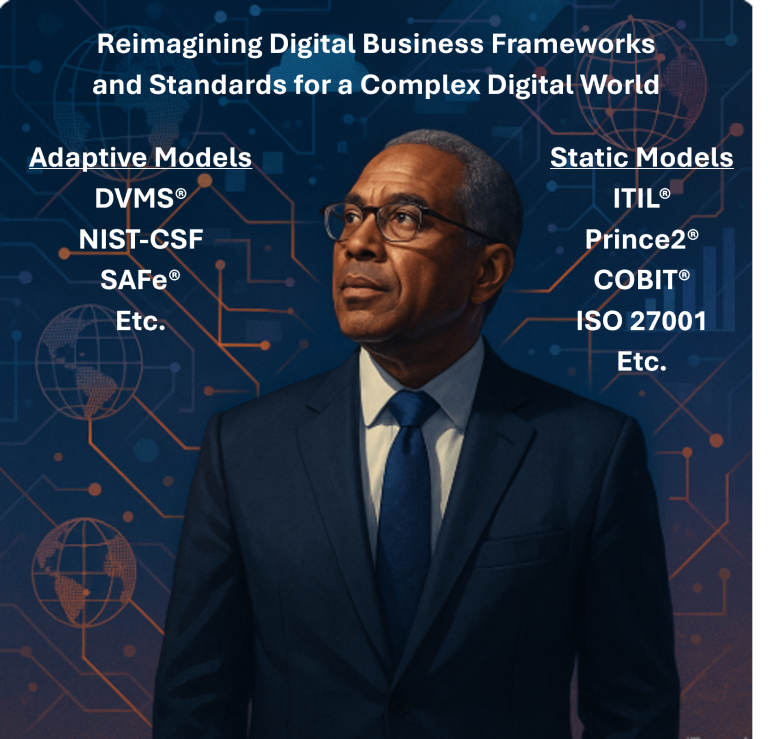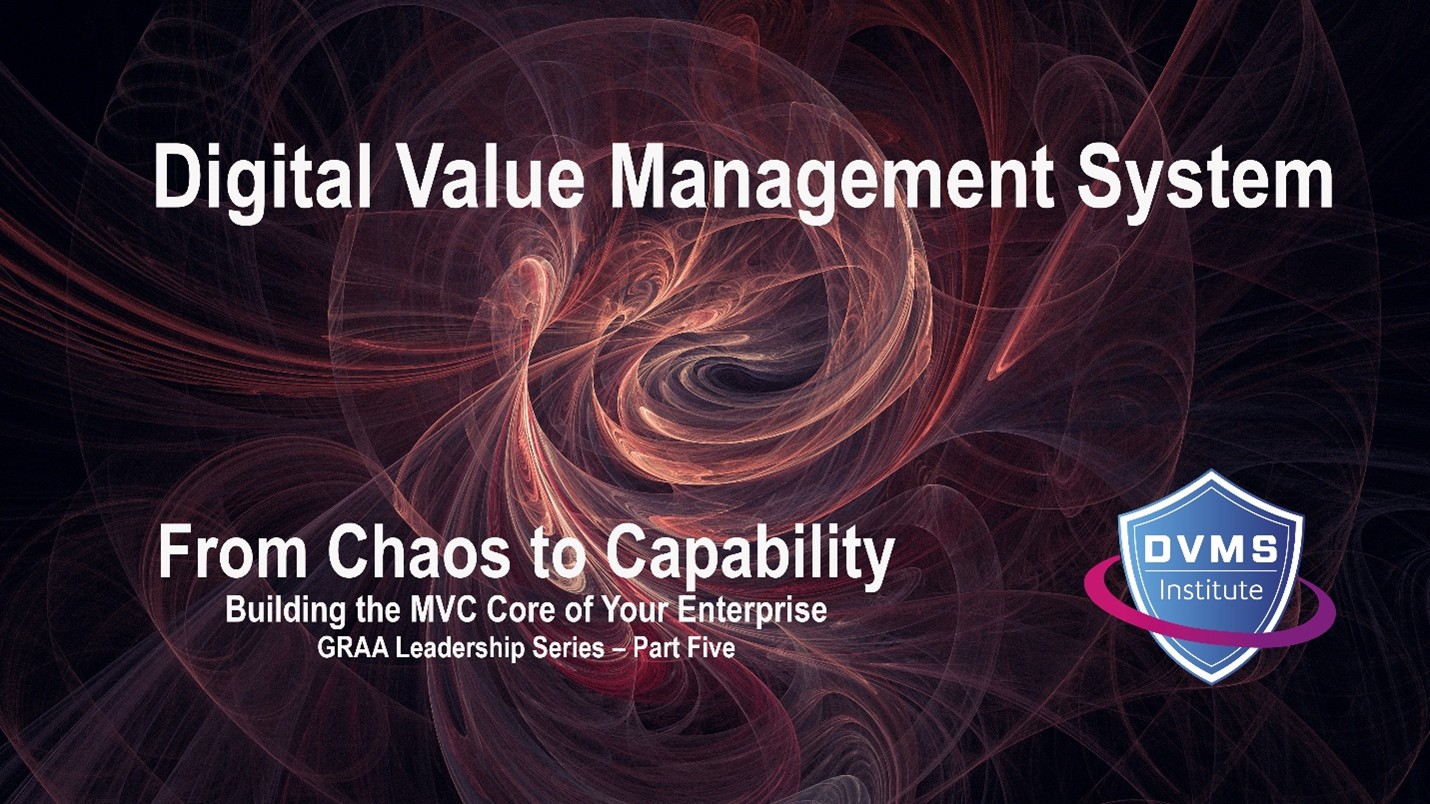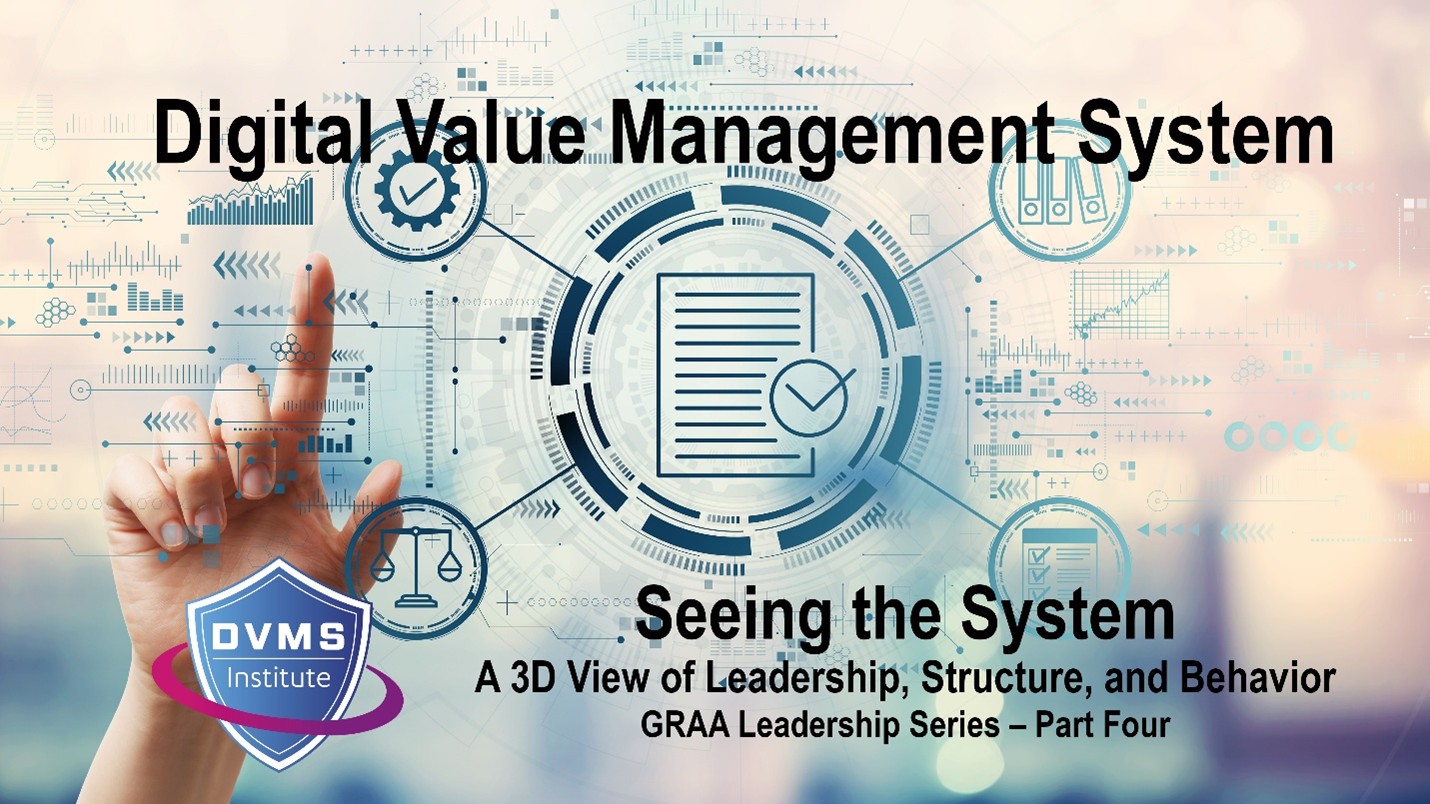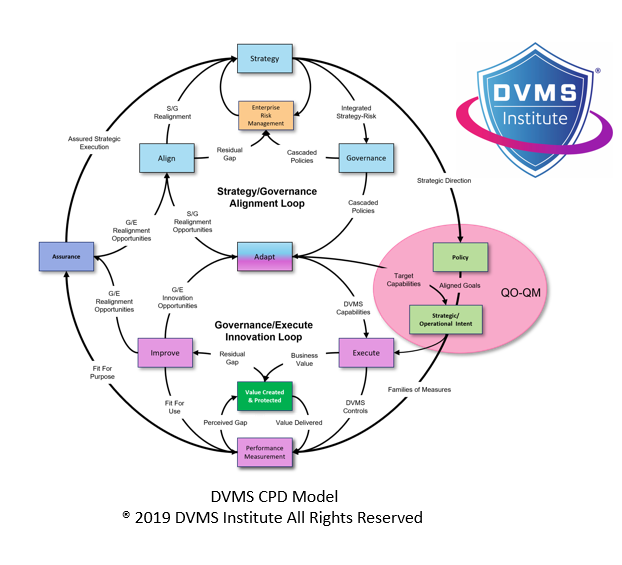Reimagining Digital Business Frameworks and Standards for a Complex Digital World
Rick Lemieux – Co-Founder and Chief Product Officer of the DVMS Institute
Introduction: The Evolution of Digital Complexity
In the past two decades, digital transformation has accelerated across every sector. From cloud computing and artificial intelligence to distributed workforces and real-time global operations, the modern digital landscape fundamentally differs from the relatively stable environments for which traditional best practice frameworks were designed. These frameworks—ITIL, COBIT, TOGAF, PRINCE2, and even ISO standards—have long served as blueprints for managing IT services, governance, architecture, and projects. While these frameworks have provided invaluable guidance, they increasingly show limitations in today’s dynamic, volatile, and interconnected digital ecosystem.
The Static Nature of Traditional Frameworks
One of the primary shortcomings of existing best practice frameworks is their static and prescriptive nature. Most of these models were conceived in an era of predictability and linear growth. They assume that organizations can plan years, design comprehensive architectures, implement structured processes, and manage change in a controlled manner. However, the real world has evolved. Businesses today must operate with agility, respond to continuous disruptions, and innovate rapidly. Static frameworks struggle to accommodate the fluidity of modern digital environments.
Moreover, these frameworks often rely on periodic updates—sometimes years apart—to remain relevant. The market and technological landscape may have shifted dramatically when a new version is released. As a result, organizations attempting to follow them too rigidly can find themselves outpaced by more adaptive competitors.
Siloed Domains and Fragmented Governance
Another major limitation is the siloed design of most best practice frameworks. ITIL focuses on service management, COBIT targets governance, TOGAF emphasizes architecture, and PRINCE2 is rooted in project management. While specialization has benefits, the digital world does not operate in silos. Cloud infrastructure decisions affect cybersecurity, agile development impacts governance, and data privacy influences architectural design. The interplay between domains is critical, yet traditional frameworks fail to integrate these perspectives holistically.
Consequently, organizations often implement multiple frameworks in parallel, leading to overlapping controls, duplicated efforts, and conflicting priorities. This fragmentation increases complexity rather than reducing it, usually leading to “framework fatigue” among teams attempting to comply with numerous, sometimes contradictory, requirements.
Inflexibility in the Face of Agile and DevOps
Modern organizations increasingly embrace Agile, DevOps, and continuous delivery methodologies to accelerate innovation and improve responsiveness. These paradigms prioritize rapid iteration, cross-functional collaboration, and customer-centric design. Unfortunately, legacy frameworks struggle to support these agile environments.
For example, ITIL’s emphasis on change approval boards and detailed process documentation can be incompatible with continuous deployment pipelines. Similarly, traditional governance models that require extensive signoffs and compliance checks can create friction in DevOps workflows. The result is a cultural clash: developers and engineers see frameworks as bureaucratic obstacles rather than enablers of success.
Unless these frameworks evolve to support speed, autonomy, and real-time decision-making, they risk becoming irrelevant or even obstructive in fast-moving digital organizations.
Poor Alignment with Digital Value Creation
Traditional frameworks were largely developed with a focus on risk management, cost control, and operational efficiency. While these remain important, the digital economy demands a stronger emphasis on value creation, customer experience, and innovation. Best practices that prioritize stability and predictability over experimentation and user-centric design are poorly aligned with digital business imperatives.
Digital-native companies—those born in the cloud and built around platforms and ecosystems—measure success by metrics such as user engagement, product adoption, and time to market. In contrast, traditional frameworks often measure process maturity, control adherence, and documentation quality. This misalignment means that organizations guided solely by traditional best practices may optimize internal processes without necessarily driving meaningful outcomes for customers or shareholders.
Insufficient Focus on Resilience and Risk Agility
In an age of cyber threats, geopolitical instability, climate risks, and supply chain disruptions, organizational resilience is no longer optional. However, many best practice frameworks still view risk management as a static, compliance-driven exercise. They focus on identifying and mitigating known risks but are ill-equipped to deal with systemic uncertainty and black swan events.
What is needed today is risk agility—the ability to sense, adapt to, and recover from unexpected disruptions in near real-time. Frameworks must evolve to incorporate dynamic risk intelligence, proactive resilience planning, and continuous monitoring across digital, physical, and organizational domains. Without these capabilities, traditional models offer a false sense of security in an inherently uncertain world.
The Absence of Systems Thinking and Value Networks
Perhaps the most profound limitation is that most frameworks were built for organizations functioning as closed systems. Today’s digital businesses, however, operate in open, interconnected ecosystems—networks of suppliers, partners, platforms, regulators, and customers. Value is no longer created within rigid boundaries but through dynamic collaboration across a digital value chain.
Systems thinking—a mindset that understands how components interact, influence, and co-evolve—is largely absent from traditional frameworks. As a result, they cannot fully support modern strategic challenges like digital ecosystem governance, multi-party risk management, or platform-based innovation. To thrive in today’s environment, organizations need guidance that reflects the interconnected, adaptive, and complex nature of their operational landscape.
Toward a New Holistic, Adaptive, and Culture-Aligned Digital Operating Model
The shortcomings of existing frameworks underscore the need for a new generation of digital operating models—ones that are agile, integrated, outcome-driven, and ecosystem-aware. These new models must blend governance with innovation, structure with adaptability, and risk management with value creation.
Some progress has been made. Emerging models like the Digital Value Management System (DVMS) from the DVMS Institute, the NIST Cybersecurity Framework (CSF) with its adaptive updates, and Scaled Agile Frameworks (SAFe) represent steps in this direction. However, there is still a gap between theory and execution, especially for large legacy enterprises that are transforming.
The path forward involves revising frameworks and rethinking how organizations approach governance, resilience, performance, culture, and transformation. Principles of modularity, experimentation, transparency, and learning must guide them.
Conclusion: Reimagining Best Practices for a Digital Future
The digital world is too fast, complex, and interconnected for yesterday’s best practices to be sufficient. While traditional frameworks have played a foundational role in IT management and governance, they are now increasingly misaligned with the needs of modern digital enterprises. Their rigidity, fragmentation, and inward focus must give way to more dynamic, integrated, and value-oriented models.
To succeed in the digital age, organizations must embrace new approaches that foster adaptability, resilience, innovation, and holistic thinking. Future frameworks will not be static checklists but living systems—flexible enough to evolve with change, robust enough to handle disruption, and intelligent enough to drive digital value at scale. Only then can they truly support sustainable success in an ever-shifting world.
About the Author

Rick Lemieux
Co-Founder and Chief Product Officer of the DVMS Institute
Rick has 40+ years of passion and experience creating solutions to give organizations a competitive edge in their service markets. In 2015, Rick was identified as one of the top five IT Entrepreneurs in the State of Rhode Island by the TECH 10 awards for developing innovative training and mentoring solutions for boards, senior executives, and operational stakeholders.
In today’s digitally driven economy, cyber disruptions are no longer an “if” but a “when.”
The DVMS Institute’s Certified Training Programs teach organizations the skills to build a Holistic and Culture-Aligned Overlay System capable of coordinating Adaptive, Governance, Resilience, and Assurance actions across a Complex Digital Ecosystem.
Achieving true cyber resilience across a complex digital ecosystem requires seamless alignment between organizational Strategy, Governance, and Operations, underpinned by a culture dedicated to sustaining and continuously innovating organizational digital value.
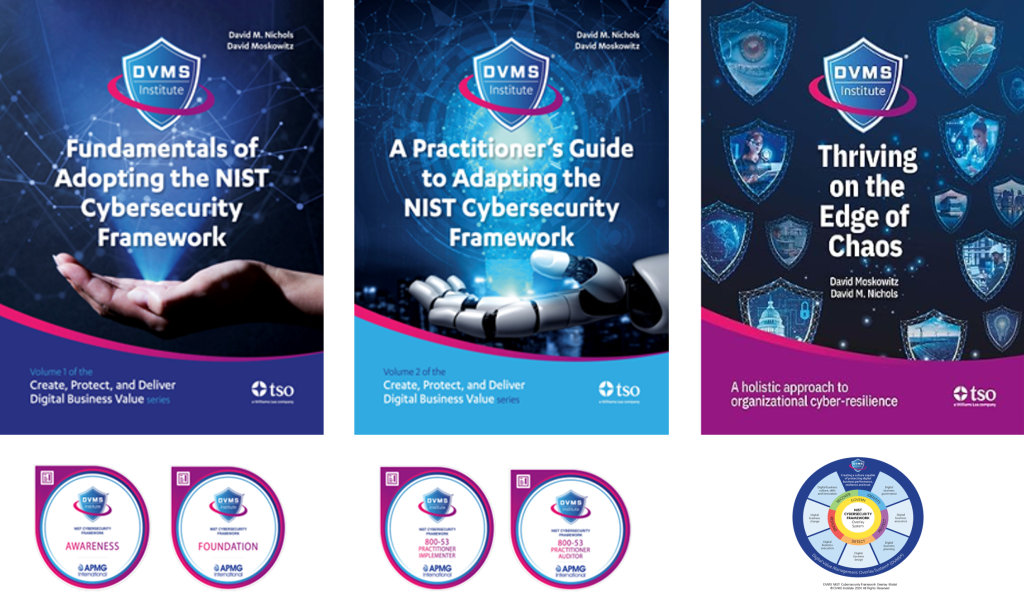
The DVMS positions cyber resilience as a strategic, enterprise-wide capability powered by the Institute’s CPD, Z-X, and 3D Knowledge models.
This systems-based approach to cyber operational resilience demands active engagement from all members of the Digital Ecosystem, with each member playing a distinct role in proactively identifying and mitigating the systemic risks that threaten digital business operations.
This adaptive, forward-looking approach to Governance, Resilience, and Assurance (GRA) positions businesses to:
- Maintain Operational Stability Amidst Constant Digital Disruption
- Drive Agility and Trust Across Your Digital Ecosystem
- Satisfy Critical Regulatory and Certification Requirements
- Leverage Cyber Resilience as a Competitive Advantage
DVMS Explainer Videos
- Architecture Video: David Moskowitz explains the DVMS System
- Case Study Video: Dr. Joseph Baugh Shares His DVMS Story.
- Overlay Model – What is an Overlay Model
- ZX Model – The MVC’s that power operational resilience
- CPD Model – Adaptable governance and assurance
- 3D Knowledge Model – Enabling holistic organizational learning
- FastTrack Model – A phased approach to cyber resilience
Digital Value Management System® is a registered trademark of the DVMS Institute LLC.
® DVMS Institute 2025 All Rights Reserved

